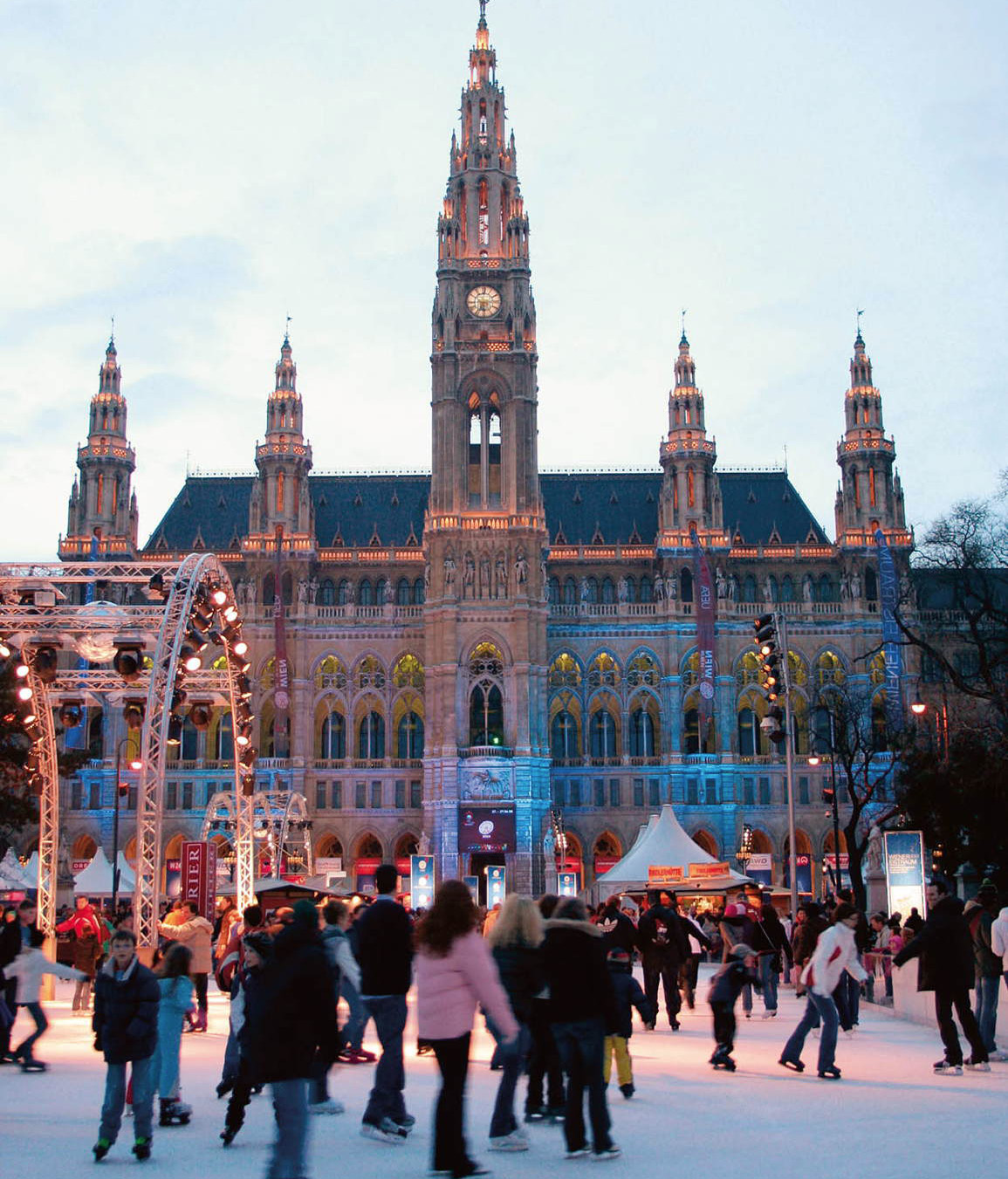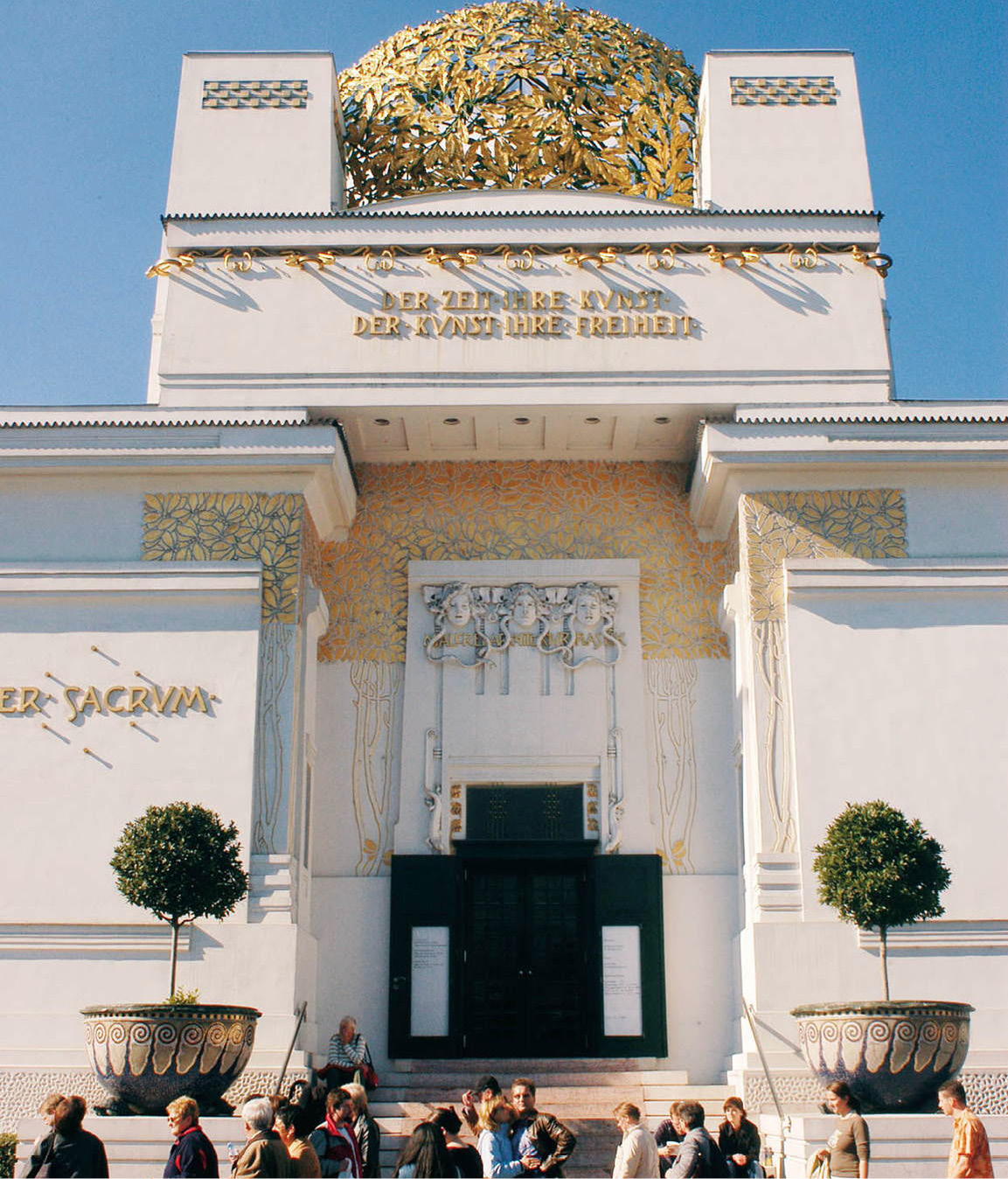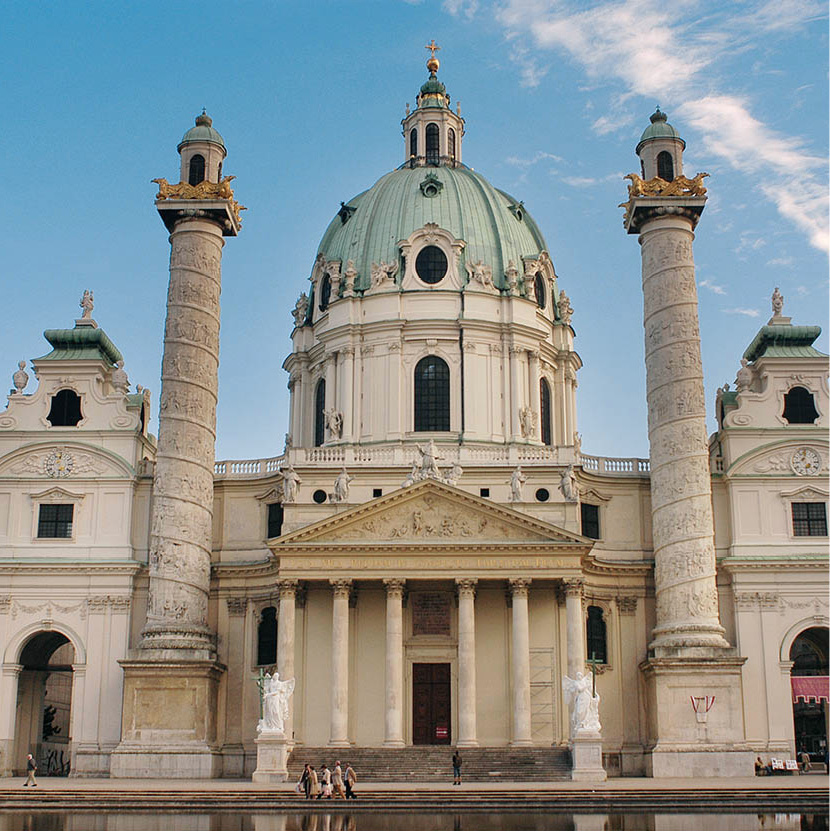Vienna is an easy city to get to know, not because nobody ever gets lost in its maze of streets and passages (they do), but because the Viennese themselves have a reputation for being courteous and helpful. There is a diversity of people here that, like most things about Vienna, can be traced directly to the far-flung Habsburg Empire.
First settled by Celts around 500 BC, and later a Roman frontier town called Vindobona, Vienna became the main seat of the Habsburg dynasty in 1278. From 1443 the Habsburgs effectively held in perpetuity the title of Holy Roman Emperor, and up until their collapse in 1918 extended their rule over a huge area of Central and Eastern Europe, from Austria through Hungary to much of Poland. Vienna was built to be the centre of a vast multinational empire, and so has a scale and grandeur far in excess of the requirements of the capital of what is now a middling-sized country.
Imperial Vienna was also a bulwark between East and West, applauded by Europe when it repelled the Turks in the Siege of 1683. Their imperial status made the Habsburgs the most prestigious of all German dynasties by far, and Vienna was the foremost cultural centre of the Germanic world, especially in the 18th century. All manner of ideas flourished among its cultural palaces and cafés. Art and music, theatre and science found the ideal climate in which to grow. Vienna was home to the greatest composers, from Haydn, Mozart and Beethoven to Schoenberg, and equally great architects, from the historicist Von Ferstel to Otto Wagner, founder in 1890s of the Vienna Secession movement, the local variant of Art Nouveau.
Even in the last years of the empire, from the 1860s to 1914, Vienna experienced a new, brief golden age, acquiring the Ringstrasse and many of its grandest buildings, and witnessing Freud founding psychoanalysis, Klimt and the Secession artists breaking new ground in visual art and Mahler producing glorious music. Its population included Czechs, Poles and many other nationalities.
When these other nationalities seized independence in 1918, grand Vienna was left only with the empire’s German-speaking rump, like a star actor reduced to playing provincial theatres. The Nazi takeover confirmed its decline; Jews – such as Freud and Mahler – had been particularly central to Viennese cultural life, and they left in droves. More recently Vienna has regained status as a meeting point for international organisations, but the sense of past glories lost is inescapable. It is the only European capital whose population, 1.7 million, is less than it was a century ago.

Ice-skating in front of the City Hall.
Fotolia
Habsburg legacy
The Habsburgs were great builders. At the heart of the Old Town they erected the immense Hofburg (Imperial Palace) 1 [map] , a town within the city, which was “always being built but never finished”. Construction began about 1220, but it was enlarged and renovated right into the 20th century, and today its sprawling buildings contain a variety of museums. The Neue Burg (Wed–Mon) wing was completed just 10 years before the collapse of the Habsburg Empire; it now houses collections of musical instruments, armour and weapons, the Ephesus Museum, with antiquities from the Greek city of Ephesus in Turkey, and the Museum für Volkerkunde (Museum of Ethnology).
The oldest part of the Hofburg is the Schweizerhof (Swiss Court), begun in the 13th century. Around it are the Imperial Apartments, spreading over several wings including the 16th-century Renaisssance Amalienburg. Nearby too are the Gothic Burgkapelle (Court Chapel), home of the Vienna Boys’ Choir, and the Stallburg or Imperial Stables, built in the 1550s as a princely residence but since used as an art gallery and stables, and now a museum on Lippizaner horses. Between the apartments are lovely courts and gardens.
Notable collections in the Hofburg include the Imperial Silver Collection (daily) and the Schatzkammer or Imperial Treasury (Wed–Mon). This contains the bejewelled crown of the Holy Roman Empire, founded in 800 by Charlemagne. Most important of all is the Albertina (daily), in a separate wing on the east side of the palace, one of the world’s greatest collections of graphic arts and engravings, including superlative drawings by Dürer and Michelangelo. The Albertina also hosts fine exhibitions of contemporary art.
Where
Tickets for Spanish Riding School performances can be obtained from the visitor centre in Michaelerplatz (Tue–Sun), at the box office in Josefsplatz (Tue–Sat), or booked online through www.srs.at.
The all-white Baroque confection of the Spanische Hofreitschule (Spanish Riding School; www.srs.at) dates from the 18th century, when it was commissioned by Emperor Karl VI. The name comes from the Spanish horses imported to breed with native Karst horses and subsequently other thoroughbreds; the famous Lipizzaner horses were first raised in Lipizza, Slovenia. It is a unique experience to watch the white stallions perform their delicate dressage steps to the music of classical dances.

Vienna’s Imperial Palace.
Britta Jaschinski/Apa Publications
Major museums
The final extension of the Hofburg that produced the Neue Burg also included the creation of two vast museums, separated from the main palace by the Ringstrasse. The Naturhistorisches Museum (Natural History Museum; Wed–Mon) 2 [map] is one of the largest museums of its kind in the world, benefiting from imperial collections of dinosaur skeletons, gemstones and other scientific artefacts initiated over 250 years ago. Opposite in an identical Renaissance-style building is the Kunsthistorisches Museum (Museum of Fine Arts; Tue–Sun) 3 [map]. This is another of the great art collections – based, again, on the imperial collection – with a vast array of paintings that includes masterpieces by Rembrandt, Vermeer, Van Eyck, Rubens, Titian, Bruegel and Velázquez, as well as sculpture, decorative art and Greek, Roman, oriental and Egyptian antiquities.
The magnificent Ring
Vienna has hundreds of palaces, large and small, but the biggest building spree the city has ever seen was the Ringstrasse, better known just as the Ring. This wide avenue, 57 metres (187ft) across, follows the line of the city’s medieval fortifications, which stood until Emperor Franz Joseph ordered them razed to allow Vienna to expand in 1857. Architectural competitions were launched, and the city received a brand-new face. The first major building to be completed, in 1869, was the Staatsoper 4 [map], Vienna’s world-renowned Opera House. Designed in a romantic Neo-Renaissance style, it was lovingly restored to its former grandeur after damage in World War II.
Tip
Vienna’s most celebrated traditional café is the Café Hawelka, just off Graben near Stephansplatz. Founder Leopold Hawelka died aged 100 in 2011, but his family assure regulars that its battered decor and fine coffees and cakes will stay unchanged.
The architect Heinrich von Ferstel set the tone of the Ring with the Votivkirche (Votive Church), to the northwest, built in gratitude for the failure of an assassination attempt against Franz Joseph in 1853. The church is Neo-Gothic in every detail, and later buildings nearby followed the style.
Von Ferstel’s other major Ring building is the university, near the church, built in a more Italian Renaissance style. The soaring architecture continues with the Neues Rathaus (City Hall) in imitation Gothic, and the parliament building in Hellenistic style. The Burgtheater 5 [map], opposite the City Hall, was built in the shape of a Greek lyre; the convex arch of the central tract is particularly impressive. Beyond the parliament building, the Ring passes through the Hofburg before reaching, just before the Danube, the Museum für Angewandte Kunst or MAK 6 [map] (Museum of Applied Arts; Tue–Sun). This is a fabulous repository of porcelain, textiles, glass and other decorative arts from around the world, with especially fine Austrian furniture, glass and other designs from Baroque to Art Nouveau. Nor is it simply a historical collection, for the MAK also presents the best contemporary design.

The Café Central, famous for its history as well as its coffee and cakes.
Britta Jaschinski/Apa Publications
The Old City
Within the Ring is the Innere Stadt or Old Vienna. Its heart is the Stephansplatz, Vienna’s most famous square and the city’s bustling centre. The south tower of the Stephansdom 7 [map] (St Stephen’s Cathedral; daily, guided tours available) gives a fabulous overview from the top of 343 steps. As an alternative, an elevator ascends the unfinished north tower as far as Pummerin (Boomer), a copy of the giant bell that was destroyed in World War II. The original Pummerin was cast in 1711 from cannons captured from the Turks. St Stephen’s (Steffl to the Viennese) was the site of many Habsburg royal marriages.
Around the asymmetrical Steffl is the smart shopping centre of Vienna, the pedestrian zone including the Graben and Kärntnerstrasse. The area behind St Stephen’s best retains the air of the past, though it is not actually the oldest quarter. In the web of narrow lanes a jumble of building styles from the 16th and 17th centuries are well preserved. In Bäckerstrasse and Schönlaterngasse, in particular, there are many bars and restaurants often thronged with people until the early hours of the morning.
Vienna’s musical heritage
Vienna loves music, and musicians of every kind thrive in Vienna. In the Burgkapelle in the Hofburg, members of the Vienna Boys’ Choir and the Vienna State Opera form the Court Music Orchestra (Hofmusikkapelle), and sing Mass at 9.15am on Sundays from mid-September to June (book through www.wsk.at).
Waltzes by Johann Strauss and Franz Lehár are especially popular in Carnival season, when elegant balls continue until dawn. Then there are the great composers like Haydn, Schubert, Mozart, Mahler, Bruckner and Schoenberg. Traces of them can be found in many streets throughout Vienna.
Among the houses which have been turned into small museums or memorials are: the house where Haydn wrote his Creation (Haydngasse 19; Tue–Sun); the apartment where Mozart spent the happiest years of his life (Figaro House, Domgasse 5; daily); the places where Schubert was born (Nussdorferstrasse 54; Tue–Sun) and died (Kettenbrückengasse 6; Fri–Sun). Beethoven had more than 25 different addresses. In 1800, he moved to Heiligenstadt in the district of Döbling. It was here at Probusgasse 6, today the Beethoven Museum (Tue–Sun), that he wrote his Heiligenstädt Testament, a moving document in which he revealed his feelings about his growing deafness.
Around the Belvedere
On the east side of the Ring lies the Stadtpark, laid out in 1862 and the most extensive patch of green in central Vienna. Its trees are reflected in the ponds and River Wien, which is flanked by a string of pavilions and a promenade.

Johann Strauss plays on in the Stadtpark.
Britta Jaschinski/Apa Publications
The Belvedere 8 [map] (daily), a palace of sumptuous proportions, was built between 1714 and 1723 for Prince Eugene of Savoy, the Empire’s greatest general. In fact, it is really two palaces, the Upper and Lower Belvedere, joined by terraced gardens. As well as their exuberant Baroque decor they contain museums (all daily). The Upper Belvedere is the grandest section, with the Palace Chapel, and houses the Österreichische Galerie (Austrian Gallery), another of Vienna’s great art collections, with stunning exhibits from the Middle Ages and the Baroque, but also major modern work by artists like Kokoschka, Klee and, above all, Gustav Klimt. The Lower Belvedere with its extraordinarily lush Baroque reception rooms, and the Orangery are now venues for temporary exhibitions, while the Palace Stables house medieval art and the Augarten workshops are an all-white space for contemporary art shows.

The Secession Building.
Britta Jaschinski/Apa Publications
Just west of the Belvedere entrance is the Karlsplatz, and the splendid Baroque Karlskirche 9 [map] (St Charles Church). The finest ecclesiastical Baroque building in the city, from 1713–37, its unique design includes a magnificent green cupola, twin triumphal pillars with spiral reliefs, and exterior belfries.
Tucked in between the Karlskirche and the Hofburg, at Friedrichstrasse 12, is the Art Nouveau Secessionsgabäude ) [map] (Secession Building; Tue–Sun). It was designed by Joseph Maria Olbrich as a demonstration of the Secession movement’s ideas and a showcase for artists such as Schiele, Kokoschka and Klimt, whose Beethoven Frieze (1902) covers three walls of a basement room.

The Baroque splendour of Karlskirche.
Britta Jaschinski/Apa Publications
Beyond the centre
A map of Vienna shows that it is laid out in concentric circles, with the Old City enclosed by the Ring and the Donaukanal (Danube Canal). On the other side of the Ring is the Vorstadt, the part of the city that grew up outside the fortifications. It is surrounded by another ring road, the Gürtel, outside of which come the suburbs, little villages such as Grinzing, Nussdorf and Severing, and their wine taverns, called heurigen.
The woods and meadows between the Danube and its canal east of the city centre enclose the Prater (daily), once a playground of emperors but a public park since 1766. Its landmark is the Riesenrad (daily), a giant Ferris wheel that arcs to a high point of nearly 65 metres (213ft). The park also offers a Planetarium, miniature railway, an old-fashioned amusement park that has recently gained some adrenalin-pumping rides, bicycle-hire shops and a swimming pool, and the lovely 4.5km (3-mile) Hauptallee (main avenue) is a favourite of joggers and cyclists.
On the east side of the city lies Schönbrunn (daily), the imperial summer residence. Perhaps the most beautiful of all the Habsburgs’ palaces, it was originally commissioned in the 1690s as a grand hunting lodge by Emperor Leopold I, but was greatly extended in the 1740s under Empress Maria Theresa, who made it her favourite residence and employed Nikolaus Pacassi to create the fabulous palace and gardens we see today.
Schönbrunn contains 1,200 rooms, around 45 of which are open to the public, including the main Imperial Apartments. There are the private rooms used by Emperor Franz Joseph – who was born in the palace and died here in 1916 – and others used by Maria Theresa, including the Breakfast Room and jewel-like Vieux-Lacque Room. In the grounds are the Baroque Zoo, the English Botanic Garden, and the Gloriette with its views over the whole complex.
Beyond Schönbrunn the city fades into the Wienerwald, the Vienna Woods, forested hills that have been a favourite place for Viennese for centuries, and famously celebrated in a Strauss waltz.